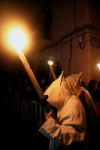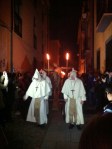Tuesday Isa and I were planning to go see the Cofradía de Jesús del Vía Crucis. Isa likes this procession because the image of Jesus is beautiful. Besides that, one of her friends was a cofrade in the procession, so, if we went early enough, we would be able to see him putting on his garb. The procession was supposed to start at 20.15, but unfortunately, the procession was cancelled because of rain. As the processions last for a couple of hours (at least) and there is no quick cover for the pasos, the processions will not happen if there is even a hint of rain. Sadly, this year, Semana Santa fell in March instead of in April, which means much more rain than usual. The procession of the Vía Crucis was not the only one to be cancelled.
There was another procession set to start at midnight, but we did not attend this one either. Instead, we were watching Spain play France. It was a very important game, as the week before Spain had tied Finland 1-1. If they did not win, Spain would have to go through a much more challenging route to qualify for the 2014 World Cup in Rio.
Watching Spain play in Zamora is different than watching them play in Barcelona. For one, Zamora has much more pride in the national team of Spain than Catalunya does. For example, my most-Catalan friend did not even watch the game, as she prefers the Catalan national team. Part of this is because Madrid and Castilla y Leon (where Zamora is located) might be considered the parts of Spain the most “neutral.” Catalunya, the Basque Country, and Galicia in the north have very unique identities separate from Spain (Galicia less so than the other two). Andalucia in the south has a greater Islamic influence and they speak in a fashion that even some native Spaniards have trouble understanding.
We watched the game in an Irish Pub (really, Irish Pubs are everywhere). In Barcelona, the most common beer is Estrella Damm, a locally produced beer. In Zamora, however, the most common beers are Heineken and Cruzcampo. This means that when you order a caña (whatever is on tap), you get Estrella Damm in Barcelona and Heineken in Zamora. Besides that, if you order a clara in Barcelona, they serve you half beer/half lemon (which is Fanta de limon). In Zamora, you have to order caña con limon to get the same thing. A clara, instead, is half beer/half gaseosa, which is a bit like sprite: carbonated water with a citrus-y taste.The most common gaseosa in Spain is La Casera.

(L to R) Torta del Duero (Tosted bread, cheese from Zamora, strawberry reduction)
Hamburgesa de Buey (Buey is castrated bull)
Montadito de bacon, pimiento, y cebolla caramelizada (bacon, red pepper, caramelized onion)
We had a combination of cañas and cañas con limon. Isa’s friend José Isaac (or Isi), called me “La American Pie” because I finished my drink before he did. His favorite movies are the seven American Pie movies, and his goal is to one day attend a party like those in the movie. The game itself was interesting, but the best part was that Spain won 1-0. (You can read a reverse-order description of the game here.) Next we stopped at Afterwork La Parrilla, a bar for tapas y copas. We ordered some tapas and wine. Hamburgesa de buey, una torta del duero, montadito de bacon, pimiento, y cebolla carmalizada. This was in preparation for Vía Crucis.























